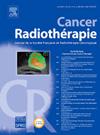脑放射线坏死的诊断和处理。
IF 1.5
4区 医学
Q4 ONCOLOGY
引用次数: 0
摘要
脑放射坏死(BRN)是立体定向放射治疗(SRT)的一种严重而复杂的副作用。区分脑放射坏死和局部肿瘤复发至关重要,需要先进的诊断技术和多学科方法。BRN通常在治疗后数月至数年出现,在核磁共振成像上表现为放射学改变,并可能产生神经症状。主要风险因素包括受照射脑组织的体积、放射剂量和既往放疗史。本手稿回顾了 BRN 的诊断过程,强调了评估基线风险、临床评估和先进成像模式的重要性。多模态成像提高了诊断的准确性,有助于区分 BRN 和肿瘤复发。治疗方法因症状而异。无症状的 BRN 可通过定期成像进行监测,而有症状的 BRN 通常需要皮质类固醇来减轻炎症。贝伐单抗等新疗法在临床试验中显示出良好的前景,可明显改善放射影像和症状。对于组织学确诊病例和严重的耐药病例,可能需要进行手术治疗。正在进行的研究旨在提高诊断准确性和治疗效果,改善患者的预后和生活质量。本综述强调了采用多学科方法和不断进步来应对脑肿瘤患者 BRN 所带来的挑战的必要性。本文章由计算机程序翻译,如有差异,请以英文原文为准。
Diagnosis and management of brain radiation necrosis
Brain radiation necrosis (BRN) is a significant and complex side effect of stereotactic radiotherapy (SRT). Differentiating BRN from local tumor recurrence is critical, requiring advanced diagnostic techniques and a multidisciplinary approach. BRN typically manifests months to years post-treatment, presenting with radiological changes on MRI and may produce neurological symptoms. Key risk factors include the volume of irradiated brain tissue, the radiation dose, and prior radiotherapy history. This manuscript reviews the diagnostic process for BRN, emphasizing the importance of assessing baseline risk, clinical evaluation, and advanced imaging modalities. Multimodal imaging enhances diagnostic accuracy and aids in distinguishing BRN from tumor relapse. Therapeutic management varies based on symptoms. Asymptomatic BRN may be monitored with regular imaging, while symptomatic BRN often requires corticosteroids to reduce inflammation. Emerging therapies like bevacizumab have shown promise in clinical trials, with significant radiographic and symptomatic improvement. Surgical intervention may be necessary for histological confirmation and severe, treatment-resistant cases. Ongoing research aims to improve diagnostic accuracy and treatment efficacy, enhancing patient outcomes and quality of life. This review underscores the need for a multidisciplinary approach and continuous advancements to address the challenges posed by BRN in brain tumor patients.
求助全文
通过发布文献求助,成功后即可免费获取论文全文。
去求助
来源期刊

Cancer Radiotherapie
医学-核医学
CiteScore
2.20
自引率
23.10%
发文量
129
审稿时长
63 days
期刊介绍:
Cancer/radiothérapie se veut d''abord et avant tout un organe francophone de publication des travaux de recherche en radiothérapie. La revue a pour objectif de diffuser les informations majeures sur les travaux de recherche en cancérologie et tout ce qui touche de près ou de loin au traitement du cancer par les radiations : technologie, radiophysique, radiobiologie et radiothérapie clinique.
 求助内容:
求助内容: 应助结果提醒方式:
应助结果提醒方式:


